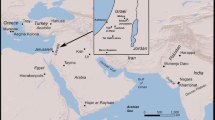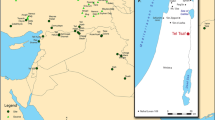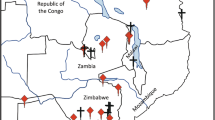Abstract
Ostrich eggshell and gastropod shell beads provide important evidence for understanding how past peoples decorated and cultured their bodies and may also be used as proxy evidence for interpreting the nature and extent of past social networks. This study focuses on the ostrich eggshell and gastropod shell bead assemblages from the terminal Pleistocene (~ 13.5 to 11.6 ka) and mid-Holocene (~ 7.3 to 6.7 ka) occupations from Grassridge Rockshelter, South Africa. We present results from a multi-method approach to understanding bead manufacture and use that combines a technological analysis of the bead assemblages with Raman spectroscopy. Raman spectroscopy analyses were conducted on surface residues identified on the beads, ochre pieces, a grooved stone, and sediment samples, and provide further insight into past behaviours and taphonomy, as well as modern contaminants. Results indicate that ostrich eggshell beads were manufactured at Grassridge during both occupations, and that bead size changed through time. Use-wear and residue analyses demonstrate the complex taphonomy associated with bead studies from archaeological contexts, and the need for further taphonomic research. These analyses also suggest that some ostrich eggshell and Nassarius beads were potentially worn against ochred surfaces, such as skin or hide, as evidenced by the amount and location of the ochreous residues identified on the beads.











Similar content being viewed by others
Data availability
The data used for this research have been provided in the manuscript and as Electronic Supplementary Materials.
References
Abadía OM, Nowell A (2014) Palaeolithic personal ornaments: historical development and epistemological challenges. J Archaeol Method Theory 22:1–28
Ambrose S (1998) Chronology of the Later Stone Age and food production in East Africa. J Archaeol Sci 25:377–392
Ames CJ, Gliganic L, Cordova CE, et al (2020) Chronostratigraphy, site formation, and palaeoenvironmental context of Late Pleistocene and Holocene occupations at Grassridge Rock Shelter (Eastern Cape, South Africa). Open Quaternary 6
Bentsen SE (2013) Controlling the heat: an experimental approach to Middle Stone Age pyrotechnology. South African Archaeological Bulletin 137–145
Bernardini S, Bellatreccia F, Casanova Municchia A, Della Ventura G, Sodo A (2019) Raman spectra of natural manganese oxides. J Raman Spectrosc
Bouzouggar A, Barton N, Vanhaeren M, d'Errico F, Collcutt S, Higham T, Hodge E, Parfitt S, Rhodes E, Schwenninger JL, Stringer C, Turner E, Ward S, Moutmir A, Stambouli A (2007) 82,000-year-old shell beads from North Africa and implications for the origins of modern human behavior. Proc Natl Acad Sci 104:9964–9969
Chappell J, Polach HA (1972) Some effects of partial recrystallisation on 14 C dating Late Pleistocene corals and molluscs. Quat Res 2:244–252
Collins B, Steele TE (2017) An often overlooked resource: ostrich (Struthio spp.) eggshell in the archaeological record. J Archaeol Sci Rep 13:121–131
Collins B, Wilkins J, Ames C (2017) Revisiting the Holocene occupations at Grassridge Rockshelter, Eastern Cape, South Africa. South African Archaeol Bull 72:162–170
Craig C, Collins B, Nowell A, Ames C (2020) The effects of heating ostrich eggshell on bead manufacturing: an experimental approach. J Archaeol Sci Rep 31:102287
Cui H, You L, Feng X, Tan W, Qiu G, Liu F (2009) Factors governing the formation of lithiophorite at atmospheric pressure. Clay Clay Miner 57:353–360
d’Errico F, Henshilwood C, Lawson G et al (2003) Archaeological evidence for the emergence of language, symbolism, and music–an alternative multidisciplinary perspective. J World Prehist 17:1–70
d’Errico F, Henshilwood C, Vanhaeren M, Van Niekerk K (2005) Nassarius kraussianus shell beads from Blombos Cave: evidence for symbolic behaviour in the Middle Stone Age. J Hum Evol 48:3–24
d’Errico F, Martí AP, Shipton C et al (2020) Trajectories of cultural innovation from the Middle to Later Stone Age in Eastern Africa: personal ornaments, bone artifacts, and ocher from Panga ya Saidi, Kenya. J Hum Evol 141:102737
d’Errico F, Vanhaeren M, Van Niekerk K et al (2015) Assessing the accidental versus deliberate colour modification of shell beads: a case study on perforated Nassarius kraussianus from Blombos Cave Middle Stone Age levels. Archaeometry 57:51–76
Dayet L, Erasmus R, Val A, Feyfant L, Porraz G (2017) Beads, pigments and early Holocene ornamental traditions at Bushman Rock Shelter, South Africa. J Archaeol Sci Rep 13:635–651
De Gelder J, Vandenabeele P, Govaert F, Moens L (2005) Forensic analysis of automotive paints by Raman spectroscopy. J Raman Spectrosc 36:1059–1067
Deacon J (1978) Changing patterns in the Late Pleistocene/Early Holocene prehistory of southern Africa as seen from the Nelson Bay Cave stone artifact sequence. Quat Res 10:84–111
Deacon J (1984) The later stone age of southernmost Africa. BAR Oxford
Fremout W, Saverwyns S (2012) Identification of synthetic organic pigments: the role of a comprehensive digital Raman spectral library. J Raman Spectrosc 43:1536–1544
Geiman I, Leona M, Lombardi JR (2009) Application of Raman spectroscopy and surface-enhanced Raman scattering to the analysis of synthetic dyes found in ballpoint pen inks. J Forensic Sci 54:947–952
Germinario G, Garrappa S, D’Ambrosio V, van der Werf ID, Sabbatini L (2018) Chemical composition of felt-tip pen inks. Anal Bioanal Chem 410:1079–1094
Henshilwood C, d’Errico F, Vanhaeren M et al (2004) Middle stone age shell beads from South Africa. Science 304:404
Hernanz A, Iriarte M, Bueno-Ramírez P, de Balbín-Behrmann R, Gavira-Vallejo JM, Calderón-Saturio D, Laporte L, Barroso-Bermejo R, Gouezin P, Maroto-Valiente A, Salanova L, Benetau-Douillard G, Mens E (2016) Raman microscopy of prehistoric paintings in French megalithic monuments. J Raman Spectrosc 47:571–578
Hitchcock R (2012) Ostrich eggshell jewelry manufacturing and use of ostrich products among San and Bakgalagadi in the Kalahari. Botswana Notes Records 44:93–105
Hitchcock RK (2017) Discontinuities in ethnographic time: a view from Africa. J Anthropol Archaeol 46:12–27
Hodgskiss T (2010) Identifying grinding, scoring and rubbing use-wear on experimental ochre pieces. J Archaeol Sci 37:3344–3358
Hodgskiss T (2013) Ochre use in the Middle Stone Age at Sibudu, South Africa: grinding, rubbing, scoring and engraving. J Afr Archaeol 11:75–95
Kandel AW, Conard NJ (2005) Production sequences of ostrich eggshell beads and settlement dynamics in the Geelbek Dunes of the Western Cape, South Africa. J Archaeol Sci 32:1711–1721
Kendall C, Eriksen AMH, Kontopoulos I, Collins MJ, Turner-Walker G (2018) Diagenesis of archaeological bone and tooth. Palaeogeogr Palaeoclimatol Palaeoecol 491:21–37
Kuhn SL, Stiner MC (2007) Paleolithic ornaments: implications for cognition, demography and identity. Diogenes 54:40–48
Lee R (1979) The !Kung san: men, women and work in a foraging society. Cambridge University Press, Cambridge
Lombard M, Wadley L, Deacon J et al (2012) South African and Lesotho Stone Age sequence updated. South African Archaeol Bull 67:123–144
Maggs T, Ward V (1980) Driel Shelter: rescue at a late Stone Age site on the Tugela River. Ann Natal Museum 24:35–70
Maguregui M, Knuutinen U, Trebolazabala J, Morillas H, Castro K, Martinez-Arkarazo I, Madariaga JM (2012) Use of in situ and confocal Raman spectroscopy to study the nature and distribution of carotenoids in brown patinas from a deteriorated wall painting in Marcus Lucretius House (Pompeii). Anal Bioanal Chem 402:1529–1539
Marshall L (1976) The! Kung of Nyae Nyae. Harvard University Press
Mazel AD (1996) Maqonqo Shelter: the excavation of Holocene deposits in the eastern Biggarsberg, thukela Basin, South Africa. South Afr Humanit 8:1–39
Mazel AD (1986) Mgede shelter: a mid-and late Holocene observation in the western Biggarsberg, Thukela Basin, Natal, South Africa. Ann Natal Museum 27:357–387
Mazel AD (1988) Nkupe Shelter: report on excavations in the eastern Biggarsbeg, Thukela Basin, Natal, South Africa. Ann Natal Museum 29:321–377
Mazel AD (1997) Mzinyashana Shelters 1 and 2: excavation of mid and late Holocene deposits in the eastern Biggarsberg, Thukela Basin, South Africa. South Afr Humanit 9:1–35
Mazel AD (1989) People making history: the last ten thousand years of hunter-gatherer communities in the Thukela Basin. South Afr Humanit 1:1–168
Miller J (2012) The ostrich eggshell beads of Mlambalasi Rockshelter, Southern Tanzania. MA, University of Alberta
Miller JM (2019) Variability in ostrich eggshell beads from the Middle and Later Stone Age of Africa. PhD, University of Alberta
Miller JM, Sawchuk EA (2019) Ostrich eggshell bead diameter in the Holocene: regional variation with the spread of herding in eastern and southern Africa. PLoS One 14:e0225143
Miller JM, Willoughby PR (2014) Radiometrically dated ostrich eggshell beads from the Middle and Later Stone Age of Magubike Rockshelter, southern Tanzania. J Hum Evol 74:118–122
Mitchell PJ (1996) Prehistoric exchange and interaction in southeastern southern Africa: marine shells and ostrich eggshell. Afr Archaeol Rev 13:35–76
Mitchell PJ (2016) Discontinuities in hunter-gatherer prehistory in southern African drylands. J Anthropol Archaeol
Opperman H (1987) The Later Stone Age of the Drakensberg and its foothills. British Archaeological Reports International Series, Oxford
Orton J (2008) Later Stone Age ostrich eggshell bead manufacture in the Northern Cape, South Africa. J Archaeol Sci 35:1765–1775
Panina N, Van de Ven R, Verwer P et al (2008) Polymorph prediction of organic pigments. Dyes Pigments 79:183–192
Pargeter J, MacKay A, Mitchell P, Shea J, Stewart BA (2016) ‘Primordialism and the ‘Pleistocene San’of southern Africa’: final reply. Antiquity 90:1087–1089
Parker JE, Thompson SP, Lennie AR, Potter J, Tang CC (2010) A study of the aragonite-calcite transformation using Raman spectroscopy, synchrotron powder diffraction and scanning electron microscopy. CrystEngComm 12:1590–1599
Raškovska A, Minčeva-Šukarova B, Grupče O, Colomban P (2010) Characterization of pottery from Republic of Macedonia II. Raman and infrared analyses of glazed pottery finds from Skopsko Kale. J Raman Spectrosc 41:431–439
Scherrer NC, Stefan Z, Francoise D, Annette F, Renate K (2009) Synthetic organic pigments of the 20th and 21st century relevant to artist’s paints: Raman spectra reference collection. Spectrochim Acta A Mol Biomol Spectrosc 73:505–524
Silberbauer GB (1981) Hunter and habitat in the central Kalahari Desert. Cambridge University Press, New York
Stewart BA, Zhao Y, Mitchell PJ, Dewar G, Gleason JD, Blum JD (2020) Ostrich eggshell bead strontium isotopes reveal persistent macroscale social networking across late Quaternary southern Africa. PNAS 117:6453–6462. https://doi.org/10.1073/pnas.1921037117
Taylor RM, Schwertmann U (1974) Maghemite in soils and its origin: I. properties and observations on soil maghemites. Clay Miner 10:289–298
Teske PR, Papadopoulos I, McQuaid CD et al (2007) Climate change, genetics or human choice: why were the shells of mankind’s earliest ornament larger in the Pleistocene than in the Holocene? PLoS One 2:e614
Tryon CA, Lewis JE, Ranhorn KL et al (2018) Middle and later stone age chronology of kisese II rockshelter (UNESCO World Heritage Kondoa Rock-Art Sites), Tanzania. PLoS One 13
Vanhaeren M (2005) Speaking with beads: the evolutionary significance of personal ornaments. From tools to symbols: from early hominids to modern humans 525–553
Wadley L (1993) The Pleistocene Later Stone Age south of the Limpopo River. J World Prehist 7:243–296
Wiessner P (1982) Risk, reciprocity and social influences on! Kung San economics. Polit Hist Band Soc 61:84
Wilmsen EN (2015) Ostrich eggshells and their beads. South African Archaeol Bull 70:89–105
Wingfield C (2003) Ostrich eggshell beads and the environment, past and present. In: Mitchell P, Haour A, Hobart J (eds) Researching Africa’s past: new contributions from British Archaeologists. Oxford, pp 54–60
Wojcieszak M (2018) Material processed with 58,000-year-old grindstones from Sibudu (KwaZulu-Natal, South Africa) identified by means of Raman microspectroscopy. J Raman Spectrosc 49:830–841
Wojcieszak M, Wadley L (2018) Raman spectroscopy and scanning electron microscopy confirm ochre residues on 71 000-year-old bifacial tools from Sibudu, South Africa. Archaeometry 60:1062–1076
Wojcieszak M, Wadley L (2019) A Raman micro-spectroscopy study of 77,000 to 71,000 year old ochre processing tools from Sibudu, KwaZulu-Natal, South Africa. Heritage Sci 7:24
Wojcieszak M, Wadley L, Prinsloo L (2019) Was yellow lead chromate pigment used during Middle Stone Age at Sibudu rock shelter (South Africa)? Journal of Raman Spectroscopy
Zilhão J (2007) The emergence of ornaments and art: An archaeological perspective on the origins of “behavioral modernity.”. J Archaeol Res 15:1–54
Acknowledgments
We thank Alex Blackwood for images of the beads, the Division of Forensic Sciences, University of Cape Town, for use of their Zeiss microscope, the Microscopy and Microanalysis Unit, University of the Witwatersrand, for use of their Olympus microscope and the Raman spectrometer, the Department of Archaeology, University of Cape Town, for space to conduct the technological analysis, as well as Andreas Lerous, Cherene DeBruyne, Lisa Rogers, Constance Neyabo, and Sylvia Mazixana who assisted with the excavation, and Roy and Jill Callaghan for their support with this research. Permits were provided by the Eastern Cape Provincial Heritage Resource Authority and the Albany Museum. We would also like to thank three anonymous reviewers for their constructive feedback on the manuscript.
Funding
Funding for this research was provided by the Leakey Foundation, Wenner-Gren Foundation (Post-Ph.D Grant #9144), and the Social Sciences and Humanities Research Council of Canada (Insight Development Grant #430-2017-00965).
Author information
Authors and Affiliations
Corresponding author
Ethics declarations
Conflicts of interest/competing interests
The authors declare no conflicts of interest or competing interests.
Additional information
Publisher’s note
Springer Nature remains neutral with regard to jurisdictional claims in published maps and institutional affiliations.
Electronic supplementary material
ESM 1
Ochre pieces analysed for this study. (PNG 17683 kb)
ESM 2
Data collected for OES beads from the MH and TP, as well for as all gastropod beads. Eleven artifacts do not have ‘stage’ indicated as this information was not captured during data entry. For the variables “color” and “staining,” “--“indicates cases where OES was too burned or otherwise degraded to permit recording of data. The variable “staining” includes all stains but when the staining is the result of ochre, ochre is specified. (XLSX 26 kb)
ESM 3
Data collected for the ochre pieces analysed for this study. (XLSX 177 kb)
ESM 4
ATR-FTIR spectra of the sediment samples; top = TP sediments and bottom = MH sediments; C = Calcite, dO-H = bending vibrations of O-H bonds, H = Haematite, K = Kaolinite, Q = Quartz and vO-H = stretching vibrations of O-H bonds. (PNG 4889 kb)
ESM 5
Raman spectra recorded on the TP sediment sample; a = anatase (TiO2), b = ilmenite (FeTiO3), c = lithiophorite (LiAl2(Mn24+Mn3+)O6(OH)6), d = haematite (α-Fe2O3), e = feldspar, f = amorphous carbon, g = quartz, h = other haematite spectrum. (PNG 4889 kb)
ESM 6
Raman spectra recorded on the MH sediment sample; a = feldspar, b = pyroxene (augite or diopside), c = quartz, d = haematite, e = possible attribution to manganese oxide and f = amorphous carbon. (PNG 4889 kb)
ESM 7
(PNG 6596 kb)
Rights and permissions
About this article
Cite this article
Collins, B., Wojcieszak, M., Nowell, A. et al. Beads and bead residues as windows to past behaviours and taphonomy: a case study from Grassridge Rockshelter, Eastern Cape, South Africa. Archaeol Anthropol Sci 12, 192 (2020). https://doi.org/10.1007/s12520-020-01164-5
Received:
Accepted:
Published:
DOI: https://doi.org/10.1007/s12520-020-01164-5




